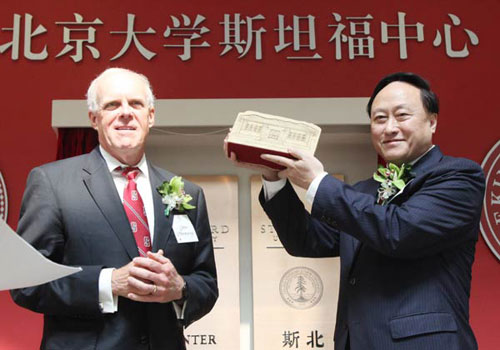Peking University, Apr.10, 2012: Following the University of Chicago, Columbia University and other top-tier international universities, Stanford University of the United States launched a research center in China on Wednesday at Peking University.

Zhu Shanlu, Party chief of Peking University, shows a stone relief, a gift from John Hennessy (left), president of Stanford University, at the Stanford Center at Peking University on Wednesday.
The center serves as the headquarters for Stanford staff conducting research and overseas programs in China.
But unlike its peers, the Stanford Center at Peking University owns a 36,000-square-meter building for Stanford's use on the Peking University campus. It is the first US university to construct a building on a major Chinese university campus.
Stanford spent $7 million on this project, which was funded entirely by the Stanford International Initiative.
The center is located beside the Weiming Lake, one of the most picturesque spots on the Peking University campus. Walking through a white ancient Japanese style bridge, visitors can see the quadrangular house with a templelike dome come into view.
The center will encourage more student exchanges, academic collaboration and faculty visits between China and the US, John Hennessy, Stanford president, said at a news conference in the center.
"Increasingly, our students want to know and understand more about China, and our researchers want to be working with their colleagues from China to solve the challenges in the world."
The president also mentioned that Peking University has begun discussions about Stanford building a center on Stanford campus, but he said he has no details to release because the talks have just started.
"I'm glad that we have a home here now," said Scott Rozelle, a Stanford University professor and leader of the Rural Education Action Project, an organization that evaluates and advises on education, health and nutrition policies in China.
Matthew Boswell, who works with Rozelle, told China Daily that they used to work at the Center for Chinese Agricultural Policy at the Chinese Academy of Sciences. "When the offices were in short supply, we would have to grab a coffee for a conference," he said. "But now we have our own place, and no longer need to go to a cafe."
Jim Plummer, dean of the Stanford School of Engineering, told China Daily that the center will serve mostly as a hub for Stanford students coming to China, because many more Chinese students have already studied at Stanford. "We want to strike a balance," he said.
Presently there are more than 1,000 Chinese students studying at Stanford. For more than 10 years, the university has enrolled more students from China than any other country out of the US, according to Hennessy.
"As a new platform for Peking University and Stanford to further students exchanges, scholars' visits and other cooperation, the center will provide an opportunity for Peking University and other Chinese universities to share resources and deepen cooperation with Stanford University, and ultimately reach a win-win situation," said Peking University President Zhou Qifeng at the opening ceremony.
Gary Locke, the US ambassador to China, voiced his thanks to Stanford for encouraging American students to study in China, to achieve President Barack Obama's 100,000 Initiative plan, which aims to send 100,000 US students to study in China in next four years.
"I hope the center will go beyond collaboration between Stanford and Peking University but also serve as a tie between Chinese universities and American ones," said Hennessy.
Edited by: Yan Binghan
Reported by: dingxiaoxiao
Source: China Daily